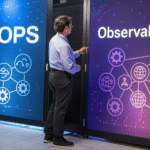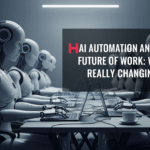AIOps vs Observability: What’s the Real Difference?

In the world of modern IT, two buzzwords often collide—AIOps and observability. Both promise smarter operations, faster incident response, and better uptime. But what’s the actual difference between the two? And more importantly, how do they work together?

In this guide, we break down AIOps vs observability in plain English. Whether you’re just starting to build your operations team or scaling across hybrid clouds, understanding these concepts will help you make better decisions.
Understanding AIOps: The Intelligent Backbone of IT Ops
AIOps stands for Artificial Intelligence for IT Operations. It’s all about using machine learning, big data, and automation to detect, diagnose, and resolve IT issues faster.
AIOps platforms analyze data across systems, identify anomalies, and sometimes even resolve issues automatically. Think of it as the brain of IT operations.
Key functions of AIOps:

- Predictive analytics
- Noise reduction from alerts
- Automated root cause analysis
- Self-healing capabilities
- Intelligent ticketing and escalation
- Cross-environment pattern recognition
A mature AIOps platform is capable of handling the data overload that overwhelms traditional monitoring systems. It brings intelligence to the chaos and filters the signals from the noise.
What Is Observability in Modern Systems?
Observability refers to how well you can understand what’s happening inside a system based on the outputs it produces. It’s about collecting telemetry logs, metrics, and traces to get deep visibility into software behavior.
If AIOps is the brain, observability is the senses—the eyes, ears, and touch that inform what’s going on.
Key pillars of observability:

- Metrics – Quantitative measures of system performance
- Logs – Time-stamped records of events
- Traces – The journey a request takes across a system
- Events – Significant changes or state transitions
- Dashboards – Visualization layers to interpret data
Observability is not just about visibility—it’s about actionable insights. It’s the foundation that supports fast troubleshooting and better system understanding.
AIOps vs Observability: Why This Comparison Matters
Modern systems generate enormous volumes of data. The challenge isn’t just seeing the data—it’s making sense of it at scale.

That’s where the AIOps vs observability debate begins:
- Observability is about gathering and exposing data.
- AIOps is about interpreting and acting on that data.
You need both, but knowing how they differ is key to building a resilient infrastructure.
Let’s use a healthcare analogy:
- Observability is like monitoring vital signs—blood pressure, heart rate, and oxygen levels.
- AIOps is the AI doctor who looks at the vitals and makes a diagnosis, even before symptoms appear.
Core Components of AIOps Explained
A mature AIOps strategy includes:
- Data ingestion: Unified collection of structured and unstructured data.
- AI algorithms: Trained on historical data to detect outliers and predict events.
- Correlation engines: Combine multiple alerts into a single, actionable incident.
- Incident management: Smart ticketing and automated escalation.
- Remediation: Predefined playbooks or automated scripts to fix problems.
Core Components of Observability Explained
Observability tools focus on visibility through:
- Telemetry instrumentation: Injected into code or deployed as agents.
- High-fidelity data: Granular metrics, verbose logs, complete traces.
- Real-time stream processing: To handle high-velocity data flows.
- Rich querying: Allowing teams to ask questions like, “What happened just before this spike?”
- Alerting rules: Triggered by changes in system behavior.
AIOps vs Observability: A Side-by-Side Comparison

| Feature | AIOps | Observability |
| Primary Function | Intelligent automation | Deep visibility |
| Driven by | AI & Machine Learning | Telemetry data |
| Main Users | SREs, Ops teams | Developers, DevOps, QA |
| Main Tools | Moogsoft, BigPanda, IBM Watson AIOps | Grafana, Datadog, Prometheus, ELK Stack |
| Response Type | Proactive & automated | Reactive & investigative |
| Value Proposition | Reduces MTTR, scales ops | Speeds root cause analysis |
Which One Comes First — Observability or AIOps?
Observability is the foundation.
You cannot run effective AIOps without good observability. If you don’t have clean, high-quality data about your system, then the AI has nothing to analyze. Like a car without fuel, AIOps without observability goes nowhere.

Start with observability, and layer AIOps on top when you’re ready to automate and predict.
Can You Have AIOps Without Observability?
Short answer: You shouldn’t.
While some legacy systems may use rule-based AIOps with minimal observability, modern AIOps solutions are only as good as the data they process. It’s like trying to cook gourmet food without ingredients—technically possible, but never delicious.
Observability as the Fuel, AIOps as the Engine
Imagine a high-speed racing car:
- Observability is the sensor system—provides feedback on tire pressure, fuel levels, and engine health.
- AIOps is the onboard computer, making split-second decisions to optimize performance and prevent breakdowns.
Together, they deliver a powerful, resilient system.
Real-World Use Cases: AIOps vs Observability
Cloud-native E-commerce:
- Observability reveals spikes in latency and memory leaks.
- AIOps links those to a failing container and restarts it automatically.
Enterprise SaaS Platforms:
- Observability shows user activity logs.
- AIOps detects suspicious behavior patterns and flags security teams.
Telecom Networks:
- Observability monitors link quality.
- AIOps auto-routes traffic through better-performing nodes.
Healthcare IT:
- Observability ensures systems meet SLAs.
- AIOps predicts potential EMR (electronic medical records) system failures before they occur.
How to Integrate Both in Your IT Strategy
- Set observability as your first goal.
- Centralize your telemetry — unify data streams.
- Evaluate your noise level — how many alerts are useful?
- Introduce AIOps when you have too much data and too few hands.
- Continuously refine — as your systems evolve, so must your observability and AI pipelines.
Challenges When Deploying AIOps or Observability
- Telemetry overload: Not knowing what to collect and what to ignore.
- Siloed tools: Each team using different dashboards.
- Poor alert hygiene: Hundreds of alerts per hour with no prioritization.
- Lack of trust: Teams may hesitate to adopt automated fixes.
- Cultural friction: Devs, Ops, and QA not aligned on metrics or SLAs.
Metrics That Define AIOps vs Observability Success
AIOps Success Indicators:
- Number of automated resolutions
- Time saved per incident
- Accuracy of anomaly detection
- False positive rate
Observability Success Indicators:
- Time to isolate root cause (MTTI)
- Percentage of systems covered
- Alert relevance score
- Usage of dashboards in daily ops
Benefits of Using AIOps and Observability Together
- From visibility to action, faster
- Human + machine synergy
- More informed decision-making
- Reduced cognitive load on engineers
- Fewer outages, shorter downtimes
- Continuous learning from incidents
AIOps vs Observability in DevOps Environments
DevOps is all about fast iteration and continuous delivery. Both AIOps and observability support this:
- Observability tells developers what’s wrong.
- AIOps helps them fix it—or better, prevent it.
The two are key to scaling DevOps without burning out your teams.
The Role of AI and Machine Learning in Each
While observability uses basic querying and rule-based alerts, AIOps leans heavily on machine learning.
AIOps can:
- Detect patterns across thousands of metrics
- Forecast future problems
- Recommend or trigger resolutions
In contrast, observability provides the raw material—the data pipelines that make learning possible.
Pros and Cons: AIOps vs Observability
AIOps Pros:
- Predictive insights
- Reduction in false alarms
- Scales faster than humans
- Accelerates digital transformation
AIOps Cons:
- Can feel like a black box
- Needs robust training data
- High implementation cost
Observability Pros:
- Increases system transparency
- Speeds up troubleshooting
- Promotes accountability and learning
Observability Cons:
- Requires ongoing tuning
- May generate alert fatigue
- Doesn’t solve problems—just shows them
Choosing the Right Focus Based on Your Needs
Use this rule of thumb:
- Low visibility? Start with observability.
- Too many alerts, slow response? Layer in AIOps.
Don’t see it as “AIOps vs observability”—see it as observability AND AIOps.
Future Trends That Will Impact AIOps and Observability
- Auto-instrumentation: Telemetry with zero developer involvement.
- AI-generated runbooks: Self-updating playbooks.
- Cross-stack correlation: Beyond infra—into business impact.
- Natural language interfaces: “Why did my service slow down?”
- AI-enhanced observability: Smarter dashboards and predictions.
Final Thoughts: Why This Isn’t a Battle, But a Partnership
AIOps vs observability isn’t a competition—it’s a collaboration.
Observability gives you the data. AIOps turns that data into action. Together, they’re transforming how modern IT operates—from firefighting to foresight.
Start where you are. Build observability. Layer in AIOps. And watch your operations go from reactive to resilient.

FAQs – AIOps vs Observability
1. What is the main difference between AIOps and observability?
AIOps focuses on analyzing and acting upon IT operational data using AI and automation, while observability centers on collecting and visualizing telemetry data—logs, metrics, and traces—to understand system behavior. Observability provides visibility, and AIOps turns that visibility into automated responses.
2. Is observability required before implementing AIOps?
Yes. Observability lays the groundwork for AIOps. Without well-instrumented systems generating high-quality data, AIOps cannot function effectively. It’s like trying to navigate in the dark—data is the light that powers AIOps insights.
3. Can AIOps replace traditional monitoring tools?
AIOps doesn’t replace monitoring—it enhances it. Traditional monitoring tools report issues; AIOps can detect patterns, predict incidents, and even resolve problems autonomously. Together, they offer a full-stack solution for modern IT operations.
4. What are the benefits of combining AIOps and observability?
The combined approach provides comprehensive visibility (observability) and intelligent response (AIOps). It improves MTTR, reduces alert fatigue, predicts outages, and enables proactive incident management, ultimately enhancing user experience and service reliability.
5. How do DevOps teams use AIOps and observability together?
DevOps teams use observability to monitor application performance and pipeline health, while AIOps handles alert correlation, anomaly detection, and automation. This combo accelerates CI/CD workflows and minimizes deployment risks.
6. Does AIOps require machine learning expertise to implement?
Not always. Many AIOps platforms come with pre-trained models and intuitive interfaces. However, deeper customization and tuning may benefit from ML knowledge. Organizations can start with vendor-supported setups and evolve as needed.
7. Are observability tools enough without AIOps?
Observability tools are vital but can be overwhelming due to the sheer volume of data. Without AIOps, teams may struggle to interpret the signals and act in time. AIOps adds intelligence and automation to make observability more actionable.
8. How does AIOps reduce alert fatigue?
AIOps uses correlation engines to group related alerts, suppress redundant ones, and prioritize based on impact. This means teams see fewer, but more meaningful, alerts—reducing noise and focusing attention where it matters most.
9. What are the top challenges in deploying AIOps?
Key challenges include data silos, lack of clean telemetry, resistance to automation, and integrating AIOps into legacy systems. Successful deployment requires cross-functional collaboration and a phased, goal-driven approach.
10. Which industries benefit most from AIOps and observability?
Industries with high uptime requirements—like finance, healthcare, telecom, and e-commerce—benefit greatly. These sectors rely on real-time insights, automation, and predictive maintenance to meet customer demands and SLAs.



